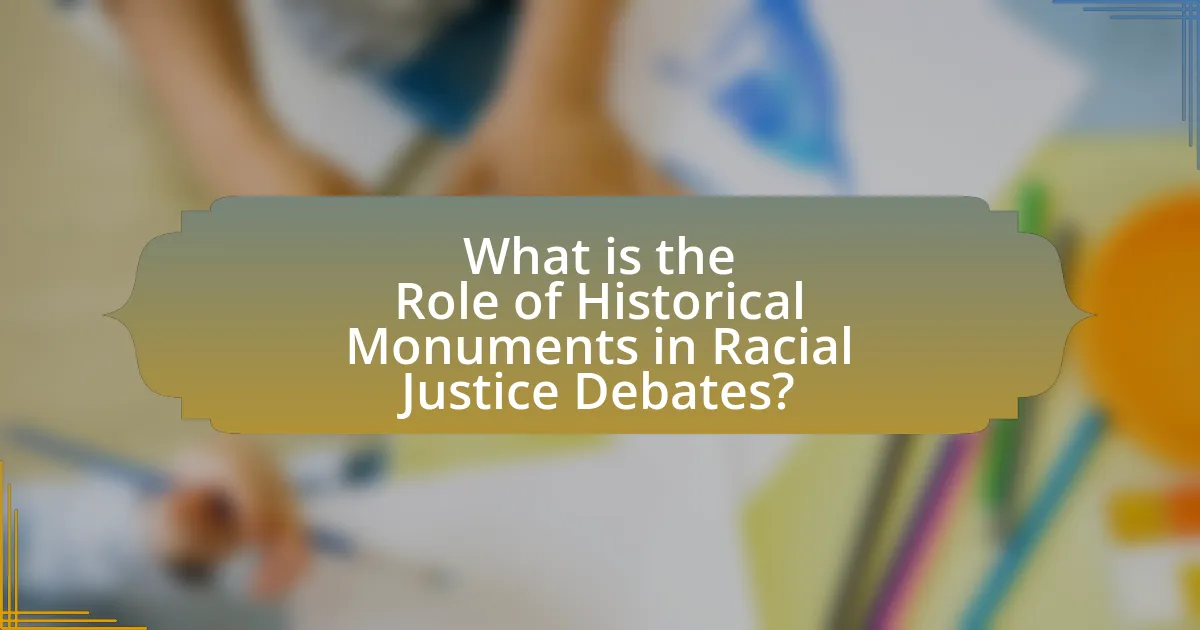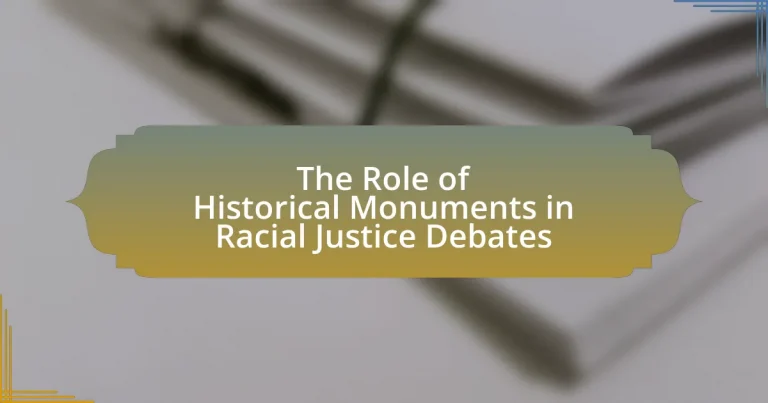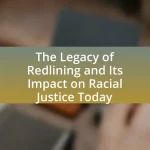Historical monuments are pivotal in racial justice debates as they symbolize historical narratives and power dynamics, often linked to colonialism, slavery, and racial oppression. The article examines how these monuments influence public perception of racial justice, convey narratives about race and history, and reflect societal values and changes. It discusses the varying interpretations of these monuments by different communities, the controversies surrounding their removal or preservation, and the implications for community identity. Additionally, it highlights best practices for addressing these monuments in the context of racial justice, emphasizing the importance of community engagement and contextualization.

What is the Role of Historical Monuments in Racial Justice Debates?
Historical monuments play a significant role in racial justice debates by symbolizing historical narratives and power dynamics. These monuments often commemorate figures or events that are associated with colonialism, slavery, or racial oppression, which can perpetuate systemic racism and marginalize communities. For instance, the removal of Confederate statues in the United States has been a focal point in discussions about racial equity, as these monuments are viewed as glorifying a history of racial violence and discrimination. The debate surrounding these monuments reflects broader societal struggles over identity, memory, and justice, highlighting the need for a more inclusive historical narrative that acknowledges the experiences and contributions of marginalized groups.
How do historical monuments influence public perception of racial justice?
Historical monuments significantly influence public perception of racial justice by embodying societal values and historical narratives. These structures often commemorate figures or events that can either reinforce or challenge prevailing views on race and justice. For instance, monuments dedicated to Confederate leaders in the United States have been criticized for glorifying a legacy of racism and oppression, leading to public outcry and calls for their removal, as seen in the 2020 protests following George Floyd’s death. Conversely, monuments that celebrate civil rights leaders, such as Martin Luther King Jr., promote a narrative of progress and equality, thereby fostering a more inclusive understanding of racial justice. The presence or absence of these monuments shapes collective memory and influences ongoing discussions about race, identity, and justice in society.
What narratives do historical monuments convey about race and history?
Historical monuments convey narratives about race and history by reflecting societal values, power dynamics, and historical events that shape collective memory. For instance, monuments dedicated to Confederate leaders in the United States symbolize a legacy of racial oppression and white supremacy, while monuments honoring civil rights figures represent progress toward racial equality. The presence or removal of these monuments often sparks debates about historical interpretation and the ongoing impact of racism, as seen in the removal of the Robert E. Lee statue in Charlottesville, Virginia, which was a response to calls for racial justice and acknowledgment of systemic racism. These actions highlight how monuments serve as focal points for discussions about race, identity, and historical accountability.
How do different communities interpret the significance of these monuments?
Different communities interpret the significance of historical monuments through varied lenses shaped by their cultural, historical, and social contexts. For instance, some communities view these monuments as symbols of heritage and pride, celebrating historical figures and events that resonate with their identity, while others perceive them as reminders of oppression and injustice, advocating for their removal or recontextualization. This divergence is evident in debates surrounding monuments like those of Confederate leaders in the United States, where African American communities often emphasize the monuments’ association with racism and slavery, contrasting with perspectives from some white communities that may see them as part of their historical legacy. Research by the Southern Poverty Law Center indicates that the removal of such monuments has been a focal point in racial justice movements, highlighting the ongoing struggle over how history is remembered and honored.
Why are historical monuments central to discussions on racial justice?
Historical monuments are central to discussions on racial justice because they often symbolize historical narratives that can perpetuate systemic racism or honor figures associated with oppression. These monuments can evoke strong emotional responses and serve as focal points for community debates about identity, memory, and justice. For instance, the removal of Confederate statues in the United States has been a significant aspect of the racial justice movement, as these monuments are seen as glorifying a history of slavery and segregation. The ongoing discussions surrounding these monuments reflect broader societal struggles over how history is remembered and who gets to shape that narrative, highlighting the need for inclusive representations that acknowledge the experiences of marginalized communities.
What historical events are commemorated by these monuments?
The historical events commemorated by these monuments include significant moments in the struggle for racial justice, such as the abolition of slavery, civil rights movements, and protests against systemic racism. For example, monuments may honor figures like Martin Luther King Jr., who played a pivotal role in the American civil rights movement, particularly highlighted during events like the March on Washington in 1963. Additionally, some monuments may commemorate the end of apartheid in South Africa, symbolizing the global fight against racial oppression. These monuments serve as reminders of the ongoing struggle for equality and the historical context of racial justice efforts.
How do these events relate to contemporary racial justice issues?
Historical events surrounding the removal or preservation of monuments related to controversial figures directly relate to contemporary racial justice issues by highlighting ongoing societal debates about representation and historical memory. For instance, the removal of statues honoring Confederate leaders has sparked discussions about systemic racism and the need for inclusive narratives in public spaces. These actions reflect a broader movement advocating for racial equity, as seen in protests following George Floyd’s death in 2020, which emphasized the importance of addressing historical injustices. The debate over monuments serves as a microcosm of the larger struggle for racial justice, illustrating how historical legacies continue to influence present-day social dynamics and policy discussions.
What controversies surround historical monuments in the context of racial justice?
Controversies surrounding historical monuments in the context of racial justice primarily involve the representation of figures associated with racism, colonialism, and oppression. Many monuments commemorate individuals who played significant roles in perpetuating systemic racism, such as Confederate leaders in the United States, leading to public outcry for their removal. For instance, the removal of the statue of Confederate General Robert E. Lee in Charlottesville, Virginia, sparked violent protests in 2017, highlighting deep societal divisions over the legacy of such figures. Additionally, debates arise over the appropriateness of honoring historical figures whose actions are now viewed as morally reprehensible, raising questions about collective memory and the values society chooses to uphold. These controversies reflect broader discussions about racial justice, equity, and the need for historical accountability.
What are the arguments for and against the removal of certain monuments?
Arguments for the removal of certain monuments include the belief that they represent oppressive historical figures or events, perpetuating systemic racism and inequality. For instance, monuments to Confederate leaders in the United States are often viewed as symbols of white supremacy, prompting calls for their removal to foster a more inclusive society. In contrast, arguments against removal emphasize the importance of historical context and education, suggesting that these monuments serve as reminders of past injustices and can facilitate discussions about history and its impact on contemporary society. Critics argue that removing such monuments may erase history rather than confront it, as seen in debates surrounding the preservation of sites related to colonialism and slavery.
How do protests and movements influence the fate of these monuments?
Protests and movements significantly influence the fate of monuments by prompting public discourse and leading to actions such as removal, relocation, or contextualization. For instance, the Black Lives Matter movement has catalyzed the reevaluation of monuments associated with racism and colonialism, resulting in the removal of statues like that of Confederate General Robert E. Lee in Richmond, Virginia, in 2020. This shift reflects a growing societal demand for accountability and recognition of historical injustices, as evidenced by numerous cities across the United States taking similar actions in response to public outcry.
How do historical monuments reflect societal values and changes?
Historical monuments reflect societal values and changes by embodying the beliefs, priorities, and historical narratives of the time in which they were created. For instance, monuments erected to honor figures associated with colonialism or slavery often reveal a society’s past acceptance of these ideologies, while contemporary movements to remove or reinterpret such monuments indicate a shift towards recognizing and addressing historical injustices. The removal of statues like that of Confederate General Robert E. Lee in Richmond, Virginia, in 2021 illustrates a societal change towards acknowledging the harmful legacy of racism and promoting racial justice. This evolution in the treatment of monuments demonstrates how public spaces can serve as battlegrounds for societal values, reflecting ongoing debates about history, identity, and justice.
What role do historical monuments play in education and awareness about racial issues?
Historical monuments serve as critical educational tools and catalysts for awareness regarding racial issues by embodying historical narratives and prompting discussions about the past. These structures often commemorate significant events or figures related to racial history, thereby providing a tangible connection to the struggles and achievements of marginalized communities. For instance, monuments dedicated to civil rights leaders, such as Martin Luther King Jr., facilitate learning about the civil rights movement and its ongoing relevance. Furthermore, the presence of controversial monuments, such as those honoring Confederate leaders, sparks debates about their implications and the narratives they perpetuate, encouraging critical examination of systemic racism and historical memory. Research indicates that public engagement with these monuments can lead to increased awareness and understanding of racial injustices, as seen in studies highlighting community discussions around the removal or preservation of such structures.
How can monuments serve as educational tools in discussions about race?
Monuments can serve as educational tools in discussions about race by providing tangible representations of historical narratives and societal values. These structures often commemorate significant events or figures related to racial history, prompting critical examination and dialogue about their implications. For instance, monuments dedicated to civil rights leaders can educate the public about the struggles for racial equality, while those honoring controversial figures may spark discussions about their legacies and the ongoing impact of racism. Research indicates that engaging with these monuments can foster awareness and understanding of systemic racism, as seen in studies like “Monuments and Memory: The Role of Public Art in Racial Justice” by authors from the University of California, which highlights how public art can influence perceptions of race and history.
What initiatives exist to reinterpret or contextualize historical monuments?
Initiatives to reinterpret or contextualize historical monuments include community-led projects, educational programs, and public art installations. Community-led projects often involve local stakeholders who engage in discussions about the meanings and implications of monuments, such as the “Monument Lab” initiative in Philadelphia, which encourages public dialogue about the role of monuments in society. Educational programs, like those implemented by the National Park Service, aim to provide historical context and promote critical thinking about the narratives represented by monuments. Public art installations, such as temporary artworks or reinterpretations, serve to challenge existing narratives and invite new perspectives, exemplified by the “Statues in the Streets” project that places contemporary artists’ works alongside traditional monuments. These initiatives collectively aim to foster a more inclusive understanding of history and address the complexities surrounding racial justice.
What are the implications of preserving or removing historical monuments?
Preserving historical monuments can reinforce cultural identity and collective memory, while removing them can address historical injustices and promote social healing. The implications of preservation include the potential for ongoing public discourse about history and identity, as monuments often symbolize significant cultural narratives. Conversely, removal can serve as a powerful statement against racism and oppression, as seen in the removal of Confederate statues in the United States, which aimed to confront the legacy of slavery and segregation. This action can lead to community division or unity, depending on public sentiment and engagement in the decision-making process.
How does the preservation of monuments affect community identity?
The preservation of monuments significantly strengthens community identity by serving as tangible representations of shared history and cultural values. Monuments often embody the collective memory of a community, fostering a sense of belonging and continuity among residents. For instance, studies have shown that communities with preserved historical sites report higher levels of civic pride and engagement, as these monuments act as focal points for local heritage and identity. Furthermore, the preservation of monuments can influence social cohesion by providing a common narrative that unites diverse groups within the community, thereby reinforcing a collective identity that is essential in discussions surrounding racial justice and historical context.
What are the potential consequences of removing controversial monuments?
Removing controversial monuments can lead to significant societal consequences, including heightened tensions among different community groups and the potential erasure of historical narratives. For instance, the removal of Confederate statues in the United States has sparked protests and counter-protests, illustrating deep divisions over historical interpretation and racial identity. Additionally, such actions may provoke discussions about the values and histories that societies choose to commemorate, potentially leading to a reevaluation of public spaces and their meanings. Historical context shows that the removal of monuments can also result in a loss of educational opportunities regarding past injustices, as these monuments often serve as focal points for discussions about history and its implications for contemporary society.
What best practices can be adopted in addressing historical monuments in racial justice debates?
Best practices in addressing historical monuments in racial justice debates include community engagement, contextualization, and adaptive reuse. Community engagement involves involving diverse stakeholders in discussions about the monuments, ensuring that voices from marginalized groups are heard. Contextualization means providing historical information that explains the significance of the monument, including its ties to racial injustice, which can educate the public and foster understanding. Adaptive reuse refers to repurposing monuments or creating new installations that reflect contemporary values and promote inclusivity, thereby transforming spaces that may have been symbols of oppression into ones that celebrate diversity and justice. These practices are supported by examples such as the removal of Confederate statues in various U.S. cities, which often followed community-led initiatives advocating for racial equity.


